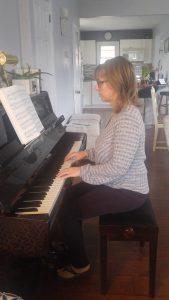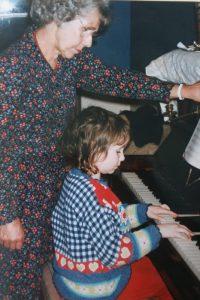As we find leisure time at home, some of us have been picking up long abandoned hobbies, such as crafting, puzzles, reading, or games. Josie and Carrie have both enjoyed a bit more time to play a musical instrument – Josie the piano, and Carrie the guitar.
From Carrie:
I have come to appreciate the ergonomics (or lack thereof) associated with guitars in the few months since I received one at Christmas. The photo above shows me playing for “my only fan,” as my kids refer to our dog, Ursa.
- Pressing the strings without touching the adjacent strings initially seemed impossible….kind of like when someone tells you to wiggle your ears. I’ve heard people say that they can’t play guitar because their hands are too small, or their fingers are too fat. Professional musicians come in all shapes and sizes, so I knew that couldn’t be true. The wrist angle and hand position required to play chords are decidedly unergonomic. I think Jeff Healey might have consulted with an ergonomist, or he must have been ergonomically-minded, with his lap steel guitar technique.
- After a few months of practice, I developed the requisite callouses on my left fingertips, which are required to play without pain. In industry, ergonomists would identify contact pressure as a hazard, and we’d suggest softer strings or protective equipment for the fingertips.
- Even when I only practice for 10 or 20 minutes, my right arm develops muscle pain. My shoulder is elevated and rotated inward in a very unnatural position. The ergonomist in me wants to lower the guitar, but then I can’t see the strings. I imagine that, some day, I’ll be able to find the strings and frets without looking, but for now that seems like a distant dream.
- I’m trying to hold the guitar on my lap, tilted up so I can glance at the strings. However, I can’t actually grip the body or neck of the guitar. My right palm rests against the body of the guitar near the bridge, and my left thumb hooks over the neck, but neither hand is very effective at keeping the guitar in place.
- Cognitively, I’m just not sure I’ll ever be able to remember the finger positions for the chords, which strings to play for each chord, and what pattern of up and down to strum. I can certainly understand how learning an instrument at my age could serve as cognitive exercise – and there are days when crosswords and sudoku seem like they might be a better choice for me!
From Josie:
My Granny taught me to play the piano; I was 4 years old when I started, and I vividly remember her always telling me to “sit up straight” and keep my “wrists loose” (see evidence below!) Turns out she was engraining ergonomics into my piano playing from a very young age, so now proper posture comes naturally to me! But not everyone starts this young, and ergonomics at the piano can really help your stamina, and add more emotion to your playing.
 Start by sitting on the front half of the bench or chair (don’t lean back into the backrest). Plant both of your feet firmly on the ground under the keys. If you use the pedals, plant your right heel on the ground in front of the sustain (right) pedal.
Start by sitting on the front half of the bench or chair (don’t lean back into the backrest). Plant both of your feet firmly on the ground under the keys. If you use the pedals, plant your right heel on the ground in front of the sustain (right) pedal.- Slide the bench or chair forward/back until you can rest your hands on either side of middle C with the elbows relaxed at your sides (upper arms vertical), the shoulders relaxed (not shrugged up toward your ears), and your back upright. This should take a bit of effort, but not too much! Your head should be balanced over your shoulders when you’re looking straight ahead, as shown at right.
- Check to see if your forearms are roughly parallel with the ground.
 Your elbows should be slightly above the height of the keys. You can sometimes adjust the height of a piano bench by turning the knobs on the sides of the bench. You can often adjust the height of the keys on a keyboard if it’s on an “X” stand (scissors to raise and lower the height of the keys). Getting the right height is a little trickier for kids, as shown at right. As you can see, at around age 5, my elbows were a bit lower than the keys, even with the bench raised as high as it would go. I remember sometimes sitting on a pillow!
Your elbows should be slightly above the height of the keys. You can sometimes adjust the height of a piano bench by turning the knobs on the sides of the bench. You can often adjust the height of the keys on a keyboard if it’s on an “X” stand (scissors to raise and lower the height of the keys). Getting the right height is a little trickier for kids, as shown at right. As you can see, at around age 5, my elbows were a bit lower than the keys, even with the bench raised as high as it would go. I remember sometimes sitting on a pillow! - If you play using sheet music, the music should be raised above the keys but not quite at eye level as you’ll often be looking between the music and the keys, especially when you first start, or when you are learning a new, challenging song. (This is similar to the “head bobbing” that occurs for hunt and peck typists.) Typically, the sheet music ledge is not adjustable on an upright or grand piano, but you may be able to adjust it up and down if you have a separate stand (often with a keyboard). You also want to find that sweet spot where you’re not reaching up too much to turn the pages; you don’t want the page turn to interrupt your playing. The higher the music, the further your arm needs to travel, and the longer the pause will be.
- Carrie feels like she will never be able to remember where to put her fingers. I have some experience there, and can say it’s all muscle memory! I recently started playing again (after about a 10-year hiatus) and I can still stumble through some of my grade 8 pieces! So, if you want to master something, you just need to sit down and keep practicing until you can play it… it’s really that simple. (Or that hard…)


